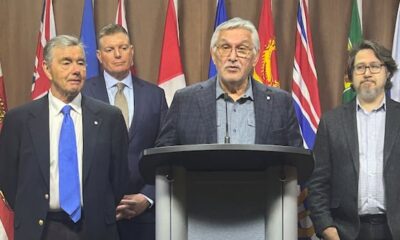Health
Ottawa and Gatineau Face Major Job Cuts Amid Public Service Review

A recent analysis by the Canadian Centre for Policy Alternatives indicates that nearly half of the anticipated job losses from proposed public service cuts will affect the National Capital Region. The report, authored by economist David Macdonald, estimates that approximately 45 percent, equating to 24,421 full-time jobs, could be lost in Ottawa and Gatineau as the federal government seeks to reduce its workforce.
The projected total job losses across the federal public service could reach 57,000 full-time equivalents by 2028. This figure reflects a significant reduction in the number of full-time positions within various government departments, a trend that has raised concerns about the broader implications for public services.
In early July, Finance Minister François-Philippe Champagne initiated a comprehensive spending review, requesting all ministers to identify 15 percent in savings within their departments over the next three years. This review follows commitments made by Prime Minister Mark Carney during his election campaign, where he vowed to “cap, not cut” the size of the public service.
According to Macdonald’s analysis, while Ottawa and Gatineau are expected to bear the heaviest burden, job losses elsewhere in Ontario could total 7,812, representing 14 percent of overall losses. In Quebec, excluding Gatineau, an additional 5,926 jobs may be lost, accounting for another 11 percent of the total.
Macdonald argues that achieving the proposed savings without layoffs would necessitate difficult choices, such as reducing transfer payments to First Nations, veteran services, and international aid. He noted, “It’s a bit of a Faustian bargain,” emphasizing the potential trade-offs inherent in budget cuts.
The departments likely to be most affected by these cuts include the Canada Revenue Agency (CRA), Employment and Social Development Canada (ESDC), and Immigration, Refugees and Citizenship Canada (IRCC). The CRA, which has already experienced job losses of around 7,000, could see this number double to 14,277 by 2028. ESDC may face full-time job losses of 2,000 in the coming year, with projections indicating this could increase to more than 4,000 by the end of the review period. The IRCC, having already reduced its workforce by 1,944 positions, is expected to similarly double its losses to 3,847 in three years.
Macdonald asserts that it is impossible to reduce departmental budgets by 15 percent without significantly impacting services provided to Canadians. He highlights a recurring pattern in which the federal government reduces its workforce, only to rehire later in response to public dissatisfaction with service delivery. “It’s definitely cheaper to make people wait online for eight hours,” he remarked, pointing to the adverse effects on Canadians trying to access vital services.
Data from the Treasury Board shows that the size of the federal public service grew substantially under former Prime Minister Justin Trudeau, before experiencing a reduction in the last fiscal year. As of 2025, the federal public service employed 357,965 workers, down from 367,772 the previous year.
Champagne’s letters reportedly instructed ministers to identify savings of 7.5 percent in the upcoming fiscal year, followed by 2.5 percent in the second year and 5 percent in the 2028-29 fiscal year, culminating in a total reduction of 15 percent. Certain federal organizations, including the offices of the auditor general and the parliamentary budget officer, have been exempted from these cuts. The Royal Canadian Mounted Police, Canada Border Services Agency, and Department of National Defence have been assigned less aggressive savings targets of 2 percent over the same period.
In an emailed statement, Rola Salem, a spokesperson for the Treasury Board, emphasized that no final decisions regarding savings have been made. “The Government’s recently announced Comprehensive Expenditure Review requests that all departments bring forward savings proposals by targeting programs and activities that are underperforming, not core to the federal mandate, duplicative, or misaligned with government priorities,” she stated.
As the government prepares for potential cuts, the focus remains on balancing fiscal responsibility with the need to maintain essential services for Canadians.
-

 Politics4 weeks ago
Politics4 weeks agoSecwepemc First Nation Seeks Aboriginal Title Over Kamloops Area
-

 World5 months ago
World5 months agoScientists Unearth Ancient Antarctic Ice to Unlock Climate Secrets
-

 Entertainment5 months ago
Entertainment5 months agoTrump and McCormick to Announce $70 Billion Energy Investments
-

 Science5 months ago
Science5 months agoFour Astronauts Return to Earth After International Space Station Mission
-

 Lifestyle5 months ago
Lifestyle5 months agoTransLink Launches Food Truck Program to Boost Revenue in Vancouver
-

 Technology3 months ago
Technology3 months agoApple Notes Enhances Functionality with Markdown Support in macOS 26
-

 Lifestyle3 months ago
Lifestyle3 months agoManitoba’s Burger Champion Shines Again Amid Dining Innovations
-

 Top Stories2 months ago
Top Stories2 months agoUrgent Update: Fatal Crash on Highway 99 Claims Life of Pitt Meadows Man
-

 Politics4 months ago
Politics4 months agoUkrainian Tennis Star Elina Svitolina Faces Death Threats Online
-

 Sports5 months ago
Sports5 months agoSearch Underway for Missing Hunter Amid Hokkaido Bear Emergency
-

 Politics5 months ago
Politics5 months agoCarney Engages First Nations Leaders at Development Law Summit
-

 Technology5 months ago
Technology5 months agoFrosthaven Launches Early Access on July 31, 2025





















